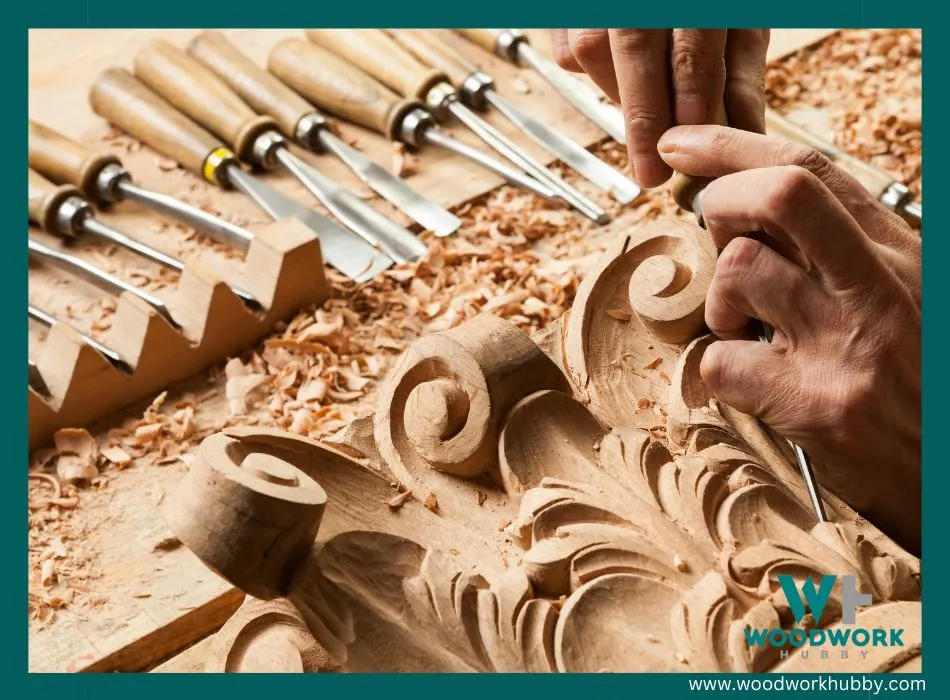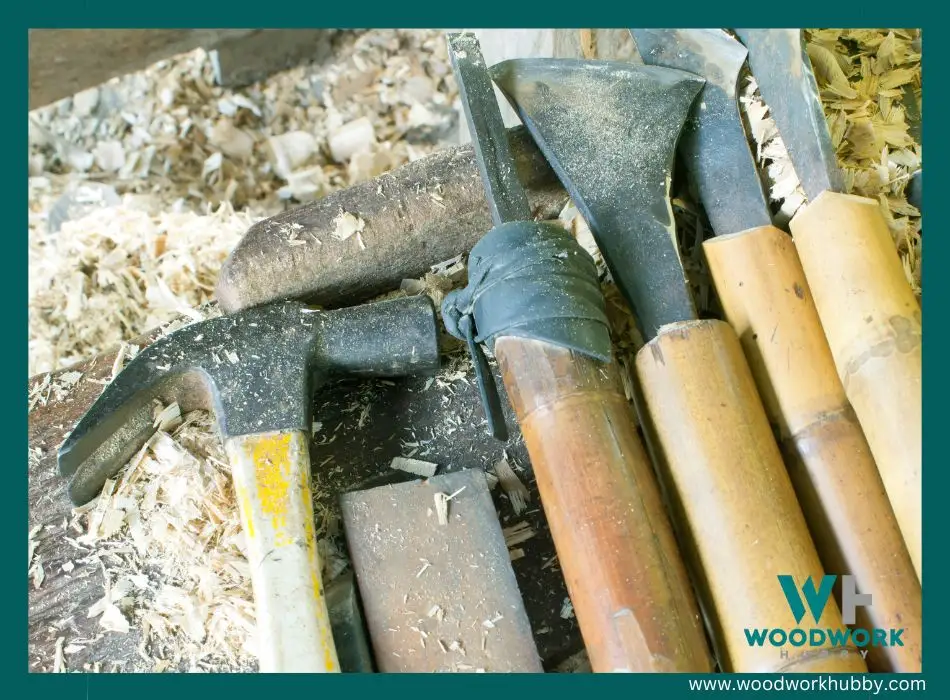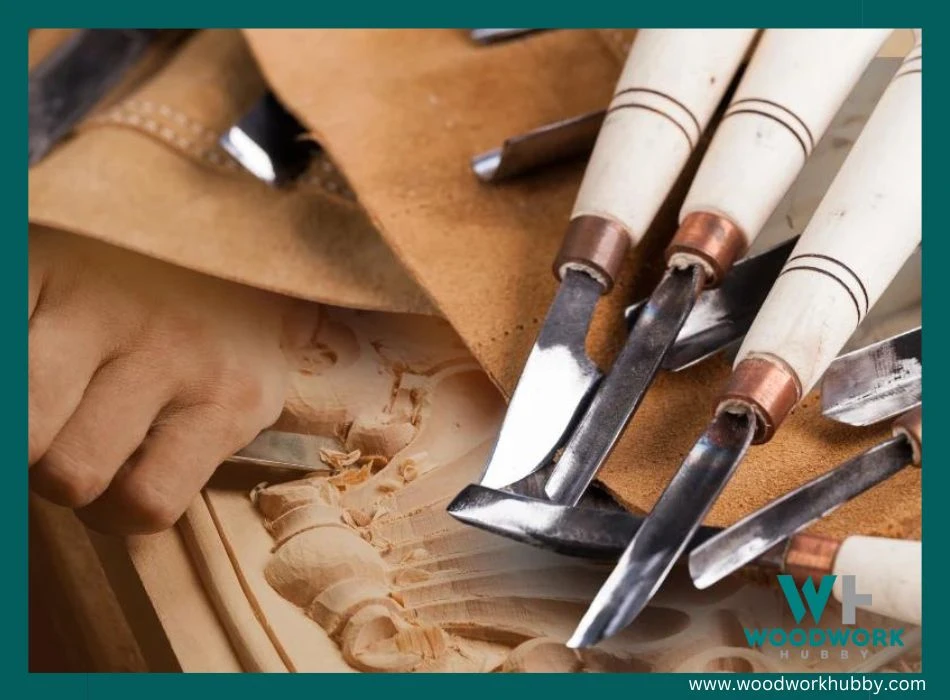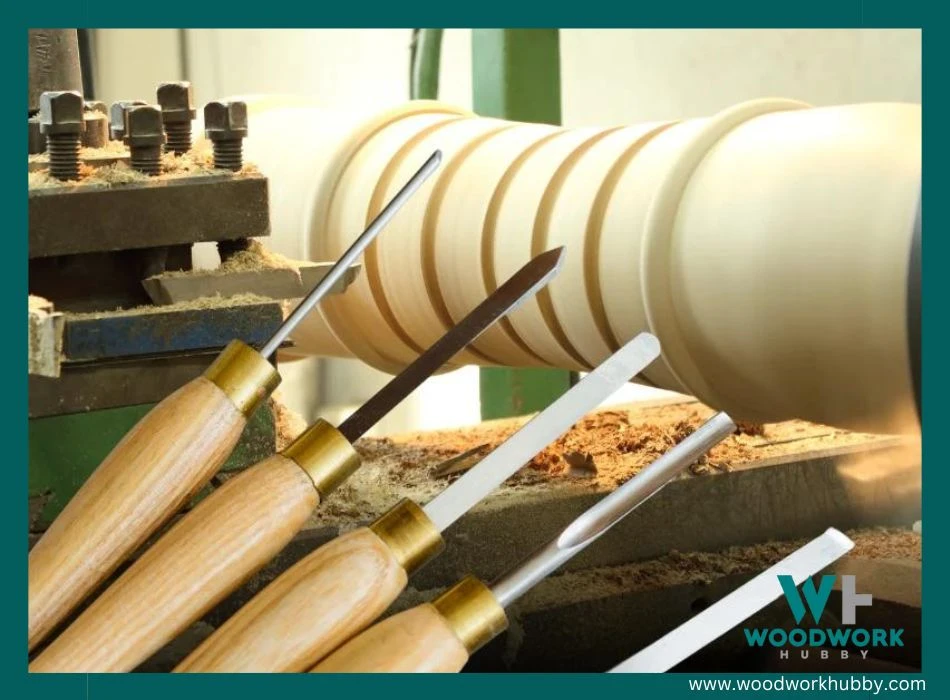If you have ever wondered whether wood carving tools woodwork on a rotary device like a lathe, you’re not alone. I have hand-carving tools, woodworking power tools, and lathe tools. And I have experimented with their cross-functionality, learning a few hard lessons. One of these lessons was can you use wood carving tools on a lathe?
You can use some carving tools on a wood lathe at slow speeds, but the results aren’t ideal. Carving tools just don’t have the weight or leverage required to stay in place while the wood turns. It requires more effort to hold carving tools in place, and the danger of the blade snapping keeps one on edge.
In this article, you will learn more about how lathe tools differ from carving tools and how you can use each one for a different woodturning purpose. If you are looking to start woodturning or working on a lathe, this will be a good resource for you.
If you’re hoping to use carving tools for perfectly turned wood, then you should read the next section to understand why that’s dangerous.
Can You Use Wood Carving Tools on the Lathe?
You can use wood carving tools on the lathe, but the results are suboptimal, and the practice can be dangerous. Wood carving and wood turning are two distinct art forms within woodcraft. Their tools are interchangeable but are akin to playing the woodcraft game on hard mode.
Wood chisels and whittling knives are the most common wood carving tools. Whittling knives are extremely dangerous on a high-speed lathe. Carving chisels are alright on a lathe but aren’t very effective for details.
Here is a table to further show the extent of compatibility between wood carving tools and a lathe.
| Wood Carving ToolCan it be used on a lathe? | Is It Dangerous? | |
|---|---|---|
| Straight Chisel | Yes | No |
| Hook/Spoon Knife | Not optimally | Yes |
| Cutting Knife | For straight-line details only | Yes, somewhat |
| Whittle Knife | Not optimally | Yes |
| Gouge Chisel | Not optimally | Yes, somewhat |
You can use wood carving tools on a lathe, but the results are likely to be disappointing. More importantly, the lathe-driven rotation of wood must be slow to avoid injury, especially with curved tools.
Carving vs. Turning: Why You Need Different Tools
The act of carving wood and of turning results in shaping wood blocks into objects of art or practical use. But the means to achieve the said end are diametrically opposite.

Wood carving refers to carving chunks of wood by hand out of a stationary block. Turning wood entails keeping a tool in position while the block rotates on a lathe. Carving tools are sharper and maximize their effect by separating from wood and coming in contact with it.
The video shows the Beginners Guide to Woodturning Tools
Each time a chisel, gouge, or knife comes into contact with wood, it carves out a piece. In wood turning, the length of time a tool remains in contact is what emphasizes its effect.
It is in the interest of a carver to have a sharper tool, while it is in the interest of a turner to have a narrower tool that he can hold still.
Using a turning tool for carving is very difficult because turning tools rarely make a difference on the first, seventh, or twentieth contact. In contrast, carving tools can make an impact upon first contact, but the chunk they chop off the turning block is not very aesthetically pleasing.
Knowing some of the lathe-compatible tools can help you understand why carving tools cannot be used on a lathe to a practical effect.

| Wood Turning Tool | Description | Effect |
|---|---|---|
| Roughing Gouge | Curved gouge/chisel-like tool. Its blade looks like half a cylinder cut across its length. | It is used to turn a rectangular block into a more curved piece. Once sufficiently curved, the material is easier to make predictable turning patterns on. |
| Skew | A chisel with a slim edge on one side that skews to a thicker one on the other. It looks like a calligraphy pen nip, except for a chisel. | It can have a smoothening effect on wood that’s turned at the right frequency. Its angular edge and sharp edge can cut off all the extra grain that introduces the roughness. |
| Spindle Gouge | A spindle Gouge is a very precise shaping tool that looks like a much narrower version of the roughing gouge. | It can be used to shape everything from broader vases to bedpost tops. The Spindle Gouge is ideal for shaping wood after a roughing gouge has already made it less angular. |
| Bowl Gouge | A bowl gouge is curved for interior carving and is generally thicker than most woodturning products. It is excellent for removing a predictable volume of wood per rotation because of the punishment it can take. | The bowl gouge is woodturning’s equivalent of a spoon knife. Where a spoon knife mainly helps make spoons out of vertical blocks, a bowl gouge mainly helps carve bowls out of rotating wood cubes. Neither the spoon knife nor the bowl gouge is confined to the project upon which they are named. |
| Parting Tool | A parting tool looks like a flat skewer. It is generally pointed but can also have varying angles towards the end. A rectangular parting tool looks like a thick utility knife blade. The diamond parting tool is the same but with a thicker blade bottom than the top. And a thin one is just thinner with a curved tip. | Parting tools are mainly used to create different pieces from a single block. They act as a knife in the turning arts but can be used later in the project to create details. |
| Scraper | This tool’s blade looks like a centered butter knife or the end of a popsicle stick. It is, of course, made of metal and is quite thick and sturdy. | A scraper is usually the most important in finishing a project. As the parting tool, the sharpest one is necessary in the beginning. The thickest tool is used to make wood the bluntest. However, this order of events is by no means necessary. |
Can I Use Carving Chisels on a Lathe?

You can technically use carving chisels on a lathe, but they do not allow enough control for turning projects. As a result, they are confined to very broad roughing use on extremely slow-turning lathes.
It is better to avoid using a carver’s chisel on lathes for the following reasons:
A Carving Chisel Is Not as Heavy as a Lathe Chisel
A turning blocking of wood puts up mechanical resistance that carving chisels never experience. They are meant to withstand one-off resistance from being hammered into wood. This thinness of the chisel is also dangerous as the blade can break, or the tool can fly out of your hand if the wood block turns abruptly.
A Carving Chisel Is Not Made for Prolonged Impact
A carving chisel cannot be held in place for a long time. Continuous rotation of wood starts producing a higher resistance load, making the chisel’s work less effective by the second.
It becomes harder to control the chisel with each passing second.
A Carving Chisel Cannot Take as Much Punishment
Finally, a carving tool is not meant to be under consistent load. Think of a plastic ruler. You might be able to bend it an inch and let it go to its original shape. You can do this 100 times.
But if you hold the tip and move it 100 inches, the plastic will break. While carving tools are much tougher than plastic, they also take punishment in episodes. If you keep persistent pressure on them, they can snap.
How Do You Carve on a Lathe?
To carve on a lathe, you need to hold the appropriate woodturning tool in place over a block of wood that’s turning on a lathe like a rotisserie chicken. The spinning of the wood removes it as you maintain prolonged contact with the wood.
If you have a wood carving background, you’re used to repeatedly hitting the wood block with a chisel or a carving knife. It is the initiation of this impact that breaks into the wood. But with a turning tool, the wood’s rotary motion is what helps the carving tool drive further and further into the wood.
The video shows how to Turn a Basic bowl.
To further clarify how lathe tools can be used to carve on a lathe, let’s explore the different methods of carving and turning used for the same means.
| Carving Tool | Turning/Lathe Tool | |
|---|---|---|
| For better detail | Slow down impact repetition and chip out finer flakes | Use a narrower tool and Hold it in a more controlled position. |
| For roughing | Use a larger tool and take angular chunks out with repeated hits | Use a broader curved blade and make your angle or motion broader |
| For better finish | Use sandpaper to erase angles | Use a blunt tool and speed up the lathe |
What Tool Do You Use on a Lathe?

The tools that you use on a lathe are called woodturning tools. They are built to be held in place for a prolonged period and have a heavier blade meant to carve wood while it turns at a high-enough pace.
A Roughing Gouge, Skew, Spindle Gouge, Bowl Gouge, Parting Tool, and Scraper make up a wood-turning tool set. These are used to shape, carve, detail, and finish wood on a lathe.
I have used and can recommend this set of turning tools on Amazon. The PSI Wood Lathe Chisel Set includes all of the above and is priced under $85. It has over 2,700 reviews and ratings that collectively add to up 4.6 out of 5 stars.
Reading reviews of this product is advisable as they come with pictures of projects made by carvers like yourself.
PSI Wood Lathe Chisel Set
Final Thoughts – Can You Use Wood Carving Tools On A Lathe?
Hand carving tools are not sufficient for a lathe. And if you plan to maintain your hand carving practice alongside woodturning, keep your woodcarving tools and yourself safe by purchasing tools specifically designed for woodturning.





